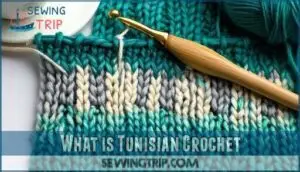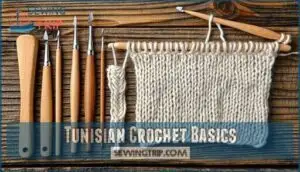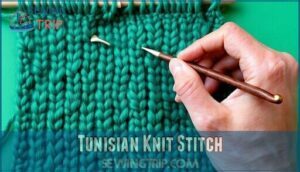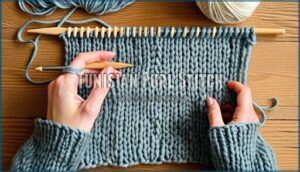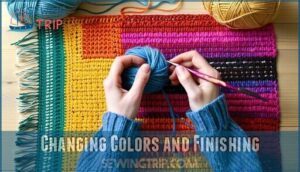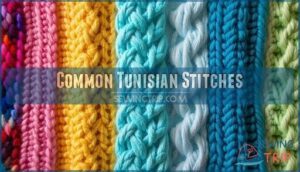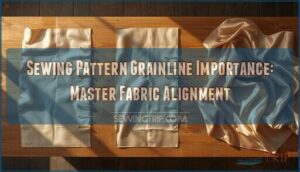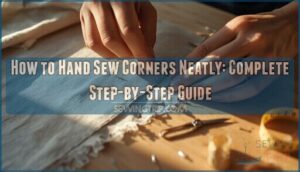This site is supported by our readers. We may earn a commission, at no cost to you, if you purchase through links.
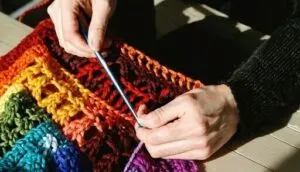
You use a long hook—kind of like a cross between a knitting needle and crochet hook—to make textured, thick fabric that’s perfect for blankets, scarves, or even garments.
What makes it unique? Instead of finishing each stitch as you go, you pick up loops across your row (forward pass) and work them off on the way back (return pass).
It’s versatile, beginner-friendly, and surprisingly addictive. However, the fabric can curl a bit, so learning a few tricks to manage that is helpful.
Ready to explore this hybrid craft?
Table Of Contents
Key Takeaways
- You’ll create thicker, textured fabric suitable for blankets, scarves, and even garments, with Tunisian crochet blending knitting and crochet techniques.
- Work your stitches in two steps—forward pass to pick up loops and return pass to remove them for unique stitch definition and a dense feel.
- Manage natural fabric curling by using larger hooks, relaxed tension, border techniques, or blocking methods for smoother results.
- Start with the right hook and yarn; larger hooks reduce tension, and smooth, medium-weight yarn highlights your stitches beautifully.
What is Tunisian Crochet
Tunisian crochet is a unique method that blends the best of knitting and traditional crochet, using a special long hook.
It creates a thicker, textured fabric that’s perfect for cozy projects like blankets and scarves.
Tunisian Vs Traditional Crochet
What makes Tunisian crochet stand out from traditional crochet? It’s the fabric density and unique hook differences.
While traditional crochet creates lighter, flexible pieces, Tunisian crochet stitches produce thicker, textured fabric that’s great for cozy projects like blankets.
The learning curve is gentle, making both techniques fun to explore. Plus, afghan crochet offers unmatched stitch complexity for creative designs, which is a key aspect of its appeal, including its potential for cozy projects.
Tunisian Vs Knitting
Tunisian crochet often surprises people because its textured fabric looks like a knitting classic—stockinette stitch.
The textured beauty of Tunisian crochet mimics the classic stockinette stitch, blending dense fabric with stunning stitch definition.
Unlike knitting’s two-needle technique, you work with a single long hook, creating dense fabric with stunning stitch definition.
Compared to knitting’s smoother, stretchier look, Tunisian has a denser feel, ideal for cozy projects.
While Tunisian crochet consumes more yarn, its faster learning curve appeals to many.
Why Learn Tunisian Crochet
If you’re looking to add a little excitement to your fiber craft skills, Tunisian crochet is your ticket.
With its unique texture, faster projects, and incredible project versatility—from cozy blankets to stylish scarves—it’s hard to resist.
Sure, it uses more yarn, but the dense, striking results are worth it.
Plus, mastering crochet techniques like the afghan stitch expands your creative toolbox effortlessly!
Tunisian Crochet Basics
Tunisian crochet is all about mastering the basics, from choosing the right hook to learning the forward and return pass.
You’ll also need to tackle the natural curling of the fabric, but don’t worry—there are simple tricks to keep it under control.
Choosing The Right Hook
Choosing the right afghan hook is like finding the perfect dance partner—it needs to flow with your style.
Tunisian hooks are longer than standard ones, with stoppers to hold loops. Flexible hooks with cables work well for big projects.
Many crafters purchase specialized crochet tools for their projects.
Match the hook size to your yarn, but go up a size or two for better drape, and consider the type of hook that suits your crochet style.
Forward and Return Pass
The magic of Tunisian crochet lies in its two-step process: the forward pass and the return pass.
During the forward pass, you add loops across your hook, building your row.
The return pass removes them, one by one, creating beautiful tension control and stitch definition.
Variations like Tunisian Simple Stitch (Tss) or Knit Stitch (Tks) add edge stability and texture.
Natural Bias and Curling
Because of its unique process, Tunisian crochet often has a natural bias, causing fabric to curl.
Curling? No problem! Tackle it with larger hooks, relaxed tension, and border techniques—smooth fabric is just a trick away!
Don’t worry—it’s fixable! Use a larger hook size, adjust your tension, or explore stitch patterns with less curling.
Blocking solutions like steam or wet blocking also help. Adding border techniques, like single crochet edges, can smooth things out beautifully.
Curling’s no match for you!
Tunisian Crochet Supplies
To get started with Tunisian crochet, you’ll need just a few specialty tools and some basic supplies.
A good hook, the right yarn, and a couple of handy notions will make your projects smooth and enjoyable, with complete concepts being essential for a successful start.
Hooks and Materials
Tunisian crochet calls for Tunisian hooks, longer than typical hooks, often with stoppers or cables.
These come in materials like bamboo, wood, metal, or plastic. Hook sizes vary widely, impacting fabric texture.
For larger projects or Tunisian crochet in the round, interchangeable or cable hooks add flexibility. Many retailers offer various hook options.
Pairing smooth yarn textures with suitable hook ergonomics guarantees enjoyable crafting every time.
Yarn Choices and Weights
Not all yarns work for Tunisian crochet, so choose wisely! Here’s what to keep in mind:
- Fiber Content: Wool is stretchy, cotton is sturdy.
- Yarn Weight: Choose chunkier yarns for warmth or lighter weight yarn for drape. Consider using thicker gauge options for quicker projects.
- Texture Effects: Smooth yarns show stitches best.
- Project Suitability: Match yarn weight to your project—blankets need heft, scarves need flow.
Essential Notions and Tools
You’ve picked your yarn, now let’s talk tools. A Tunisian crochet hook (or afghan hook) is a must-have, along with a yarn needle and stitch markers.
Row counters keep you sane, trust me. Bigger hook sizes help newbies avoid tight stitches. Hook materials range from aluminum to bamboo, so pick what feels good.
| Tool | Purpose | Tip | Variants |
|---|---|---|---|
| Afghan Hook | Holds all loops | Choose smooth material | Aluminum, Wood |
| Yarn Needle | Weaving loose ends | Blunt tip works best | Plastic, Metal |
| Stitch Markers | Tracks stitch placement | Try locking ones for security | Plastic, Metal |
| Row Counter | Counts rows | Keep it handy for quick access | Manual, Digital |
The Tunisian crochet hook and other tools are essential for a smooth crochet experience. With the right tools, you can ensure your project turns out as expected, and using a yarn needle for weaving loose ends is a crucial step.
Basic Tunisian Stitches
If you’re ready to try Tunisian crochet, starting with a few basic stitches is the way to go.
These stitches, like the Simple, Knit, and Purl, form the foundation for endless creative projects.
Tunisian Simple Stitch
The Tunisian Simple Stitch (Tss) is perfect for beginners.
It’s a basic stitch that creates dense fabric, great for beginner projects like scarves or dishcloths.
Work the forward pass by inserting the hook under the vertical bar, then the return pass removes loops.
Tss variations can reduce curling while adding stitch height, making it versatile for Tunisian crochet projects.
Tunisian Knit Stitch
The Tunisian Knit Stitch (Tks) creates a knit-like fabric that looks just like stockinette knitting.
To master it, insert your hook between the front and back vertical bars for precise hook placement.
Its even stitch height works well for pattern adaptations like textured blankets or garments.
Compared to Tunisian Simple Stitch, Tks gives a smoother, denser look, perfect for bold, structured designs.
Tunisian Purl Stitch
If you enjoyed the knit-like look of the Tunisian Knit Stitch, the Tunisian Purl Stitch (Tps) offers a softer, textured vibe.
With Tps, the yarn stays in front as you work under the vertical bars. It’s perfect for cozy projects like scarves or blankets.
One can also create texture using seed stitch combinations.
Struggling with Tps fabric density? Use a larger hook for looser stitches and smoother results, achieving the desired texture.
Advanced Tunisian Techniques
Once you’ve mastered the basics, advanced Tunisian techniques open up a world of creative possibilities.
You’ll learn how to shape your work, create seamless rounds, and add color changes to bring your projects to life.
Increasing and Decreasing
Adding or reducing stitches lets you shape your Tunisian crochet projects with finesse.
Use edge increases for wider ends, middle decreases for sleek shaping, or invisible shaping for seamless patterns.
Adjust your rate calculations based on designs for scarves or blankets.
- Edge Increases: Add loops at row ends.
- Middle Decreases: Combine stitches skillfully.
- Invisible Shaping: Perfect for subtle pattern adjustments.
Working in The Round
Working on circular projects with Tunisian crochet is simpler than it seems.
You’ll use a double-ended crochet hook, working forward passes with one hook and return passes with the other.
The spiral technique creates seamless rounds for items like market bags or beanies.
Here’s a quick visual:
| Tool | Purpose |
|---|---|
| Double-Ended Hook | Builds spiral rounds |
| Circular Hook | Large, flexible pieces |
| Stitch Markers | Tracks your progress |
| Yarn | Colorful creations |
| Tutorials | Learn smooth techniques |
Reorganizing the structure improves readability by logically grouping complete concepts into separate lines, with double new lines to visually separate each group.
Changing Colors and Finishing
Changing colors in Tunisian crochet adds personality to your projects.
Follow these steps for smooth shifts:
- Colorwork techniques: Switch yarns by dropping the old color and looping in the new during the return pass.
- Weaving ends: Secure loose ends neatly for a polished look.
- Edging options: Add a border for extra flair and reduce curling with blocking methods.
Tunisian Crochet Projects
You’ll love how versatile Tunisian crochet projects can be, whether you’re making a cozy scarf or a warm blanket.
It’s a great way to turn simple stitches into beautiful, practical pieces you’ll actually use, with beautiful being a key aspect of what makes these projects enjoyable.
Beginner Friendly Projects
When starting with Tunisian crochet, beginner-friendly projects like Easy Dishcloths, Simple Scarves, and Baby Blankets are perfect.
These easy crochet patterns let you focus on mastering basic techniques without stress.
Try making Headbands or experimenting with Washcloth Patterns—they’re practical and fun!
Tunisian crochet for beginners is all about simplicity, so get started with these beginner-friendly, easy crochet projects and build your skills.
Scarves and Blankets
Scarves and blankets are perfect Tunisian crochet projects, combining practicality and warmth.
Focus on scarf widths that suit personal style or blanket sizes for cozy layers.
Yarn quantity depends on stitch density—Tunisian stitches use more yarn!
Borders can reduce curling and add polish, while warm blankets and crochet scarves make thoughtful gifts.
Many websites offer free scarf patterns for all skill levels.
Explore colors and patterns for endless creativity, making them perfect for thoughtful gifts.
Garments and Accessories
If scarves and blankets keep you warm, garments and accessories let you shine.
Tunisian crochet is perfect for stylish layers and fun details.
Try:
- Tunisian Hats: Cozy, chunky rib designs scream winter warmth.
- Summer Tops: Light, breathable pieces for sunny days.
- Bag Designs: Create sturdy totes with unique patterns.
Accessorize with jewelry accents to elevate your look!
Common Tunisian Stitches
You’ll find a variety of common Tunisian stitches that range from basic to intricate, each adding unique texture and style to your projects.
From the airy lace stitch to the bold basket weave and even elegant cables, there’s something here for every crafter to explore.
Tunisian Lace Stitch
Tunisian Lace Stitch creates a lightweight, airy fabric perfect for shawls or summer projects.
It blends well with stitches like Tunisian Simple Stitch (Tss) or Tunisian Knit Stitch (Tks).
Many knitters find that ribbing adds structure to the edges of their work.
Experiment with lace stitch variations, yarn choice, and blocking techniques to refine texture and drape. Explore stitch patterns for elegant projects with an artful, delicate touch!
Tunisian Basket Weave
The Tunisian Basket Weave stitch stands out with its textured, woven look, making it ideal for cozy projects.
Combining Tunisian Simple Stitch (Tss) and Tunisian Knit Stitch (Tks), it’s beginner-friendly and versatile.
- Weave Texture: Alternating boxes create the effect.
- Yarn Choice: Use soft, medium-weight yarns.
- Pattern Variations: Easy four-row repeat.
- Project Ideas: Blankets, zipper bags, or scarves.
Tunisian Cables and Mesh
Just like the basket weave adds depth, Tunisian cables bring striking texture to projects using clever stitch placement.
Combine Texture Combinations like cables and Mesh Variations for lightweight pieces.
With Pattern Adaptations, you can blend cables with a lace stitch or Tunisian Simple Stitch (Tss).
Use these techniques for standout Project Ideas, from elegant scarves to cozy blankets.
Getting Started With Tunisian
Starting Tunisian crochet is easier than it looks, and all you need is the right hook and some yarn.
Practice the foundation chain and simple stitches, and you’ll quickly get into the rhythm.
Foundation Chain and Preparation
Before starting your Tunisian crochet adventure, proper foundation chain prep matters. Keep the chain loose—tight loops lead to struggles later. Match your hook size to your yarn’s thickness for smoother stitches and better yarn compatibility.
Count each stitch carefully to avoid surprises. Remember that basic stitches matter when beginning a new project.
Finally, prevent twisting by laying your starting chain flat before you continue with your forward pass.
- Chain Looseness: Keep it relaxed for easy stitching.
- Hook Size: Choose one that complements your yarn.
- Stitch Count: Double-check for accuracy.
- Preventing Twisting: Keep the foundation row straight.
Return Rows and Stitch Patterns
As you master the foundation steps, handling return rows shapes your Tunisian crochet patterns beautifully.
Think of it like tying loops together to complete the rhythm.
Combine Return Pass Variations with Stitch Pattern Complexity to explore textures and drape.
Here’s a quick guide:
| Stitch Type | Forward Pass | Return Pass |
|---|---|---|
| Tss (Simple) | Under front bar | Yo, pull through loops |
| Tks (Knit) | Between vertical bars | Yo, pull through loops |
| Purl (Tps) | Yarn front, under bar | Yo, pull through loops |
Tips and Tricks for Beginners
When diving into Tunisian crochet, remember these starter tips:
- Use a larger hook size to ease yarn tension and prevent curling.
- Count your stitches (yes, every row!) to avoid uneven edges.
- Keep edge control with a chain or slip stitch on the last stitch.
- Practice the Tunisian Simple Stitch (Tss) for a strong foundation, which is a complete concept to master for better crochet results.
Frequently Asked Questions (FAQs)
What is special about Tunisian crochet?
Tunisian crochet shines for its dense, textured fabric, making it perfect for cozy blankets and scarves.
It cleverly blends knitting and crochet techniques, works up faster than both, and creates a look that’s uniquely its own, with a style that is uniquely its own.
Is Tunisian crochet easier than regular crochet?
Some find Tunisian crochet easier because there’s no flipping your work, and it feels more rhythmic.
But, it can take practice to manage the longer hook and denser fabric without frustration.
What is a common mistake in Tunisian crochet?
Skipping the foundation chain or making it too tight is a typical mistake.
It can make your work curl more or feel uneven.
Loosen up, and don’t be afraid to go bigger with your hook!
What is the ideal hook size for Tunisian crochet?
Using the right hook size is like finding the perfect dance partner—it should feel natural.
Go two sizes larger than the yarn suggests.
This extra room softens the fabric and reduces frustrating curling issues.
Is there a difference between Tunisian and regular crochet?
Regular crochet uses one hook, and you turn your work.
Tunisian crochet feels like blending knitting and crochet, with a long hook holding multiple loops, and the fabric stays facing you.
It’s like cousins, not twins!
How long does it take to learn Tunisian crochet?
Learning Tunisian crochet is like riding a bike—you’ll wobble at first, but with practice, you’ll steady up.
In just a week or two, you’ll master basic stitches and gain confidence.
What type of yarn is best for Tunisian crochet projects?
Go for smooth, medium-weight yarn to start.
Cotton or acrylic works wonders—easy to handle and highlights stitches beautifully.
Avoid splitty or fuzzy yarns; they’re tricky.
Remember, your hook size matters for flexibility and texture, and choosing the right yarn is crucial for a successful project, with cotton being a popular choice.
Is Tunisian crochet more difficult than regular crochet?
Twists and turns of Tunisian crochet might seem tricky, but it’s not tougher—it’s just different.
If you’re patient and enjoy learning patterns, you’ll pick it up quickly.
Plus, the textured results are totally worth it!
Can Tunisian crochet be used for amigurumi projects?
You can use Tunisian crochet for amigurumi, but it’s tricky.
The dense fabric suits some designs, though shaping is harder with its rigidity.
Traditional crochet might be easier for the tight curves amigurumi needs, as Tunisian crochet can be limiting in this aspect.
How do you repair mistakes in Tunisian crochet?
Mistakes in Tunisian crochet? No worries! Undo stitches by pulling loops back to the error, then rework them.
Secure loops to prevent unraveling. Start fresh if needed—every crafter’s been there.
It’s how you learn!
Conclusion
Tunisian crochet is your gateway to a world of textured, cozy creations.
It blends the best of knitting and crochet, offering endless possibilities for beginners and seasoned crafters alike.
Whether you’re making warm blankets, trendy scarves, or versatile garments, this craft’s unique techniques keep things exciting.
Just remember, a little practice goes a long way in mastering the hooks and stitches, so grab your hook, pick your yarn, and get started with the art of Tunisian crochet today!
- https://www.purlsoho.com/create/2015/10/13/tunisian-crochet-scarf/
- https://tlycblog.com/the-pilson-blanket-a-modern-patchwork-crochet-baby-afghan
- https://mypoppet.com.au/makes/tunisian-crochet-washcloths/
- http://makeanddocrew.com/brushland-tunisian-crochet-scarf
- https://bhookedcrochet.com/2016/09/16/tunisian-simple-stitch/

